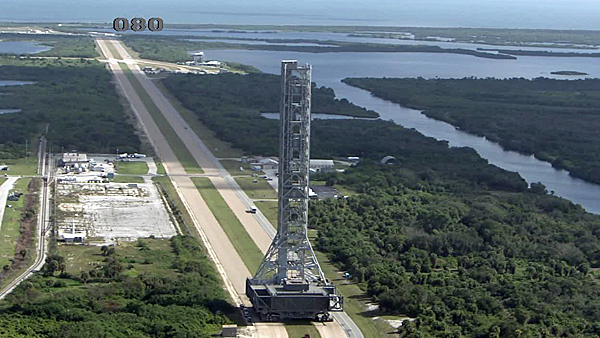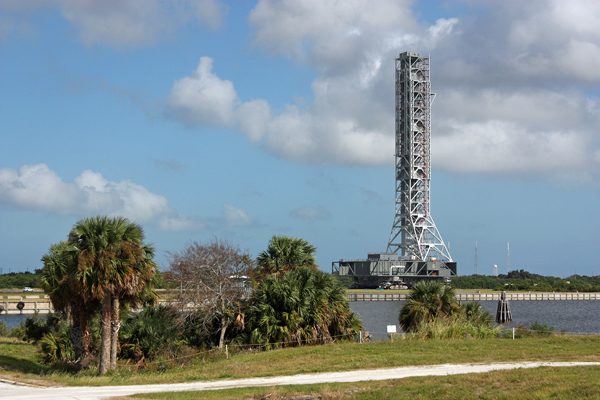Mobile launcher moved to pad for engineering tests
11/16/2011 12:24 PM Filed in: Space News | Exploration
By WILLIAM HARWOOD
CBS News
KENNEDY SPACE CENTER, FL--NASA's towering 355-foot-tall mobile launch tower, built for the now-canceled Ares I rocket, was slowly hauled to launch pad 39B Wednesday for structural tests and fit checks before modifications to support the agency's planned heavy-lift Space Launch System rocket now on the drawing board.
Reminiscent of the huge launch umbilical towers built for NASA's Saturn 5 moon rockets, the 6.8-million-pound Ares mobile launcher, mounted atop a powerful crawler-transporter, began the 4.2-mile trip from its Vehicle Assembly Building parking place to launch complex 39B at 9:15 a.m. EST (GMT-5).
The trip was expected to take about six hours, with starts and stops along the way to measure the structure's stability. Once in place atop the seaside launch pad, engineers will carry out two weeks of tests and fit checks.
NASA spent about $238 million on the mobile launcher project through the end of the Constellation moon program. The agency expects to spend another $100 million modifying the base of the structure to accommodate the larger heavy lift rocket intended for eventual flights to a variety of deep space targets.
Additional modifications are planned later, but officials say the work will be done in time to support an initial unmanned test flight in 2017.
CBS News
KENNEDY SPACE CENTER, FL--NASA's towering 355-foot-tall mobile launch tower, built for the now-canceled Ares I rocket, was slowly hauled to launch pad 39B Wednesday for structural tests and fit checks before modifications to support the agency's planned heavy-lift Space Launch System rocket now on the drawing board.
 |
| NASA's mobile launcher, built for the canceled Ares I rocket and scheduled for modifications to support the agency's new heavy lift booster, creeps toward pad 39B Wednesday for structural tests and fit checks. (Credit: NASA) |
Reminiscent of the huge launch umbilical towers built for NASA's Saturn 5 moon rockets, the 6.8-million-pound Ares mobile launcher, mounted atop a powerful crawler-transporter, began the 4.2-mile trip from its Vehicle Assembly Building parking place to launch complex 39B at 9:15 a.m. EST (GMT-5).
The trip was expected to take about six hours, with starts and stops along the way to measure the structure's stability. Once in place atop the seaside launch pad, engineers will carry out two weeks of tests and fit checks.
 |
| The mobile launcher heads toward launch complex 39B, visible in the distance to the right of the gantry. (Credit: Stephen Clark/Spaceflight Now) |
NASA spent about $238 million on the mobile launcher project through the end of the Constellation moon program. The agency expects to spend another $100 million modifying the base of the structure to accommodate the larger heavy lift rocket intended for eventual flights to a variety of deep space targets.
Additional modifications are planned later, but officials say the work will be done in time to support an initial unmanned test flight in 2017.